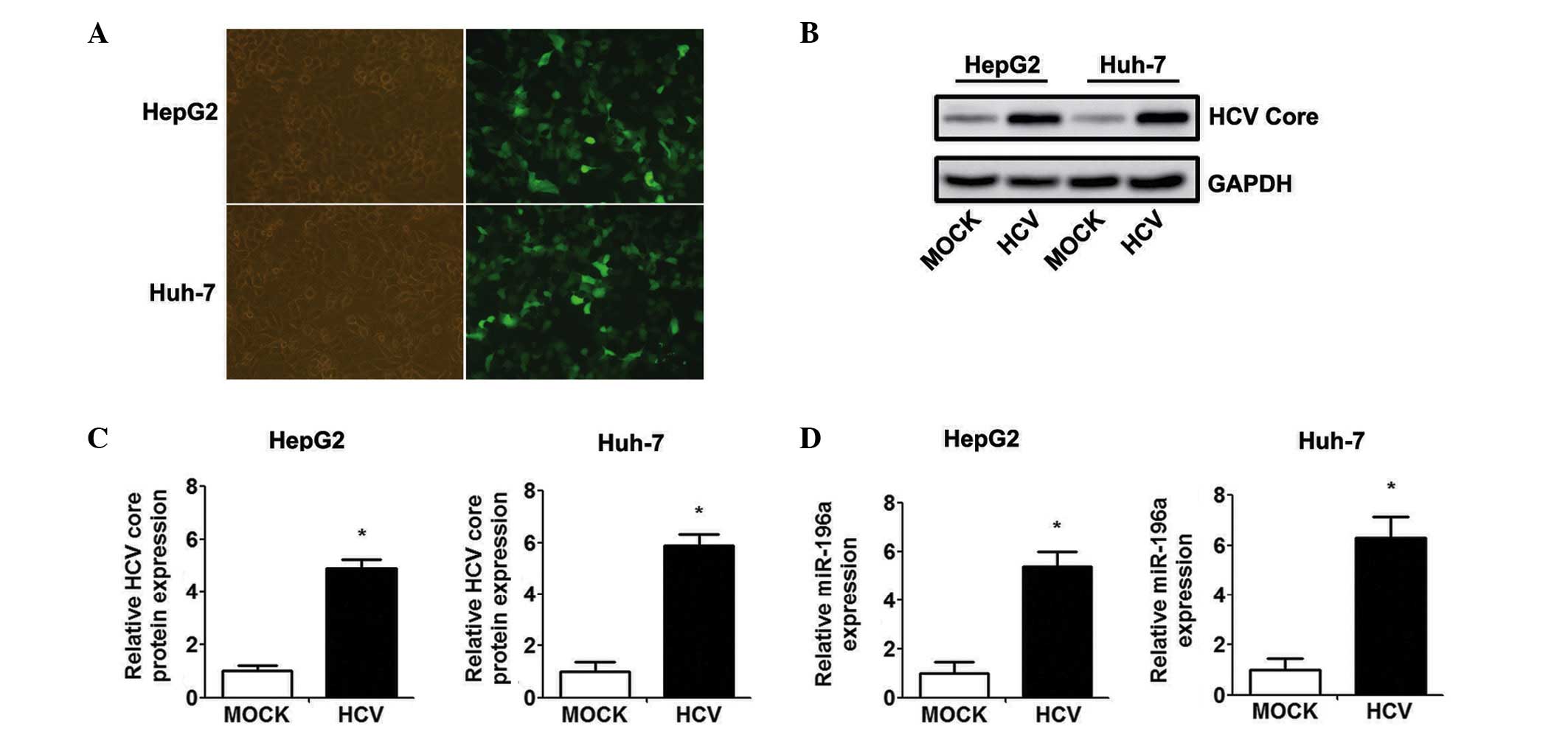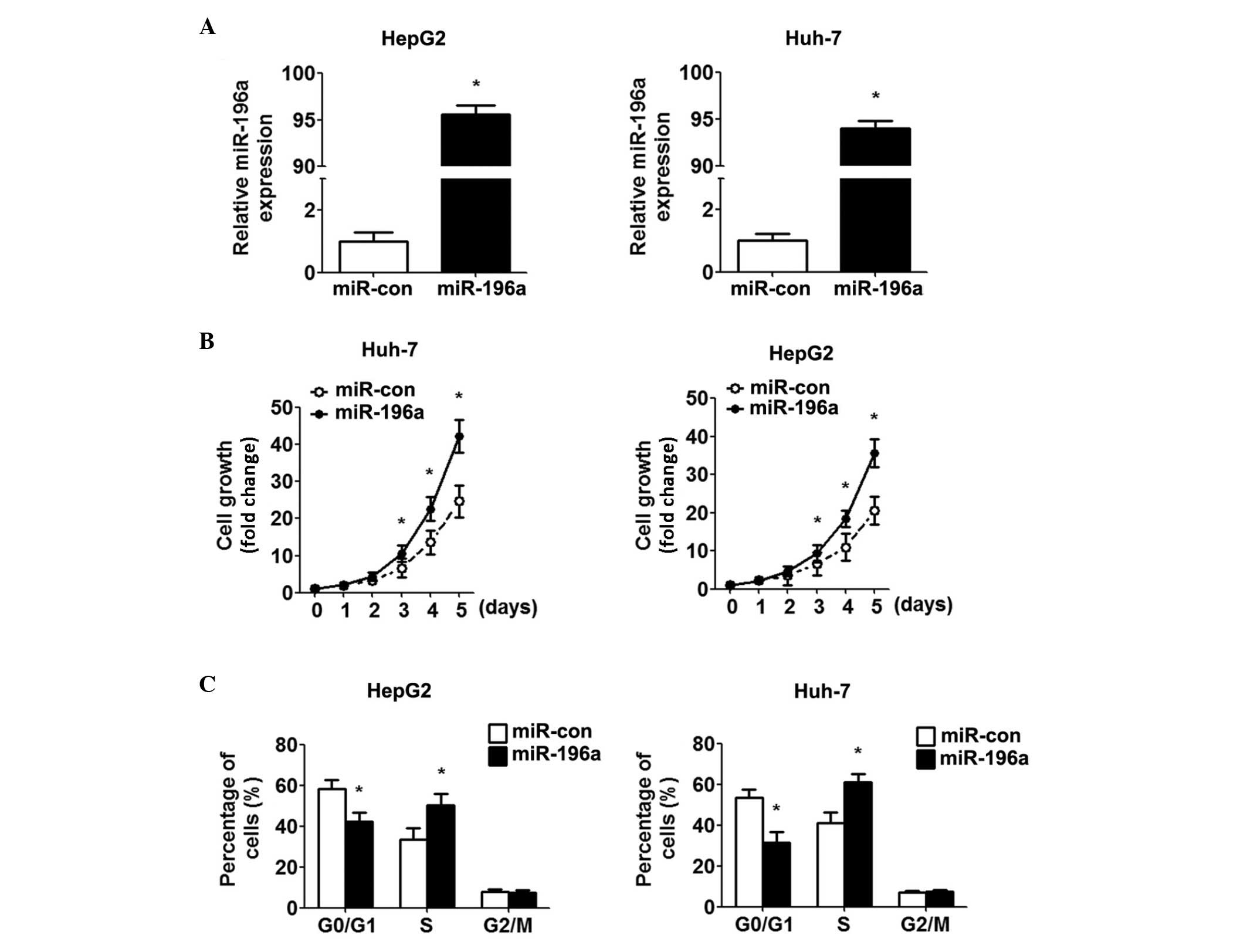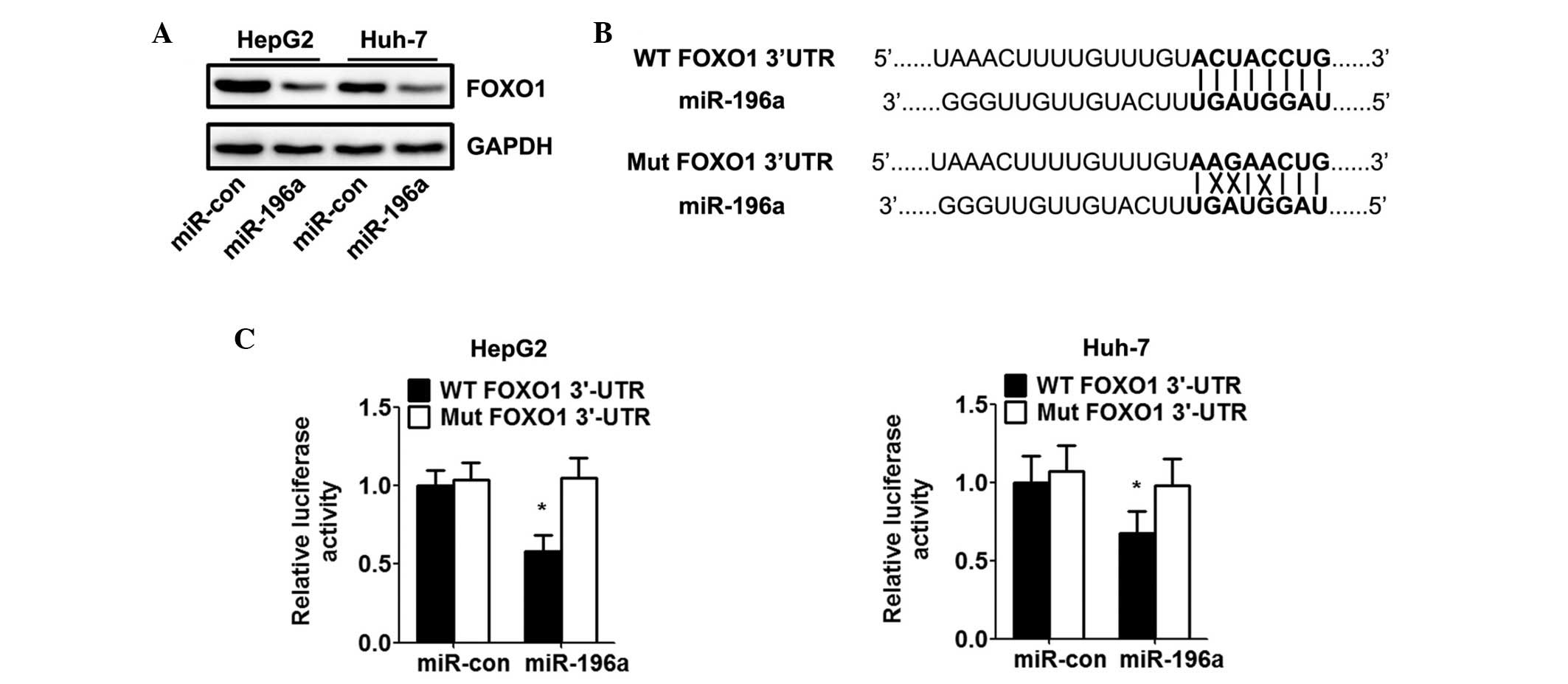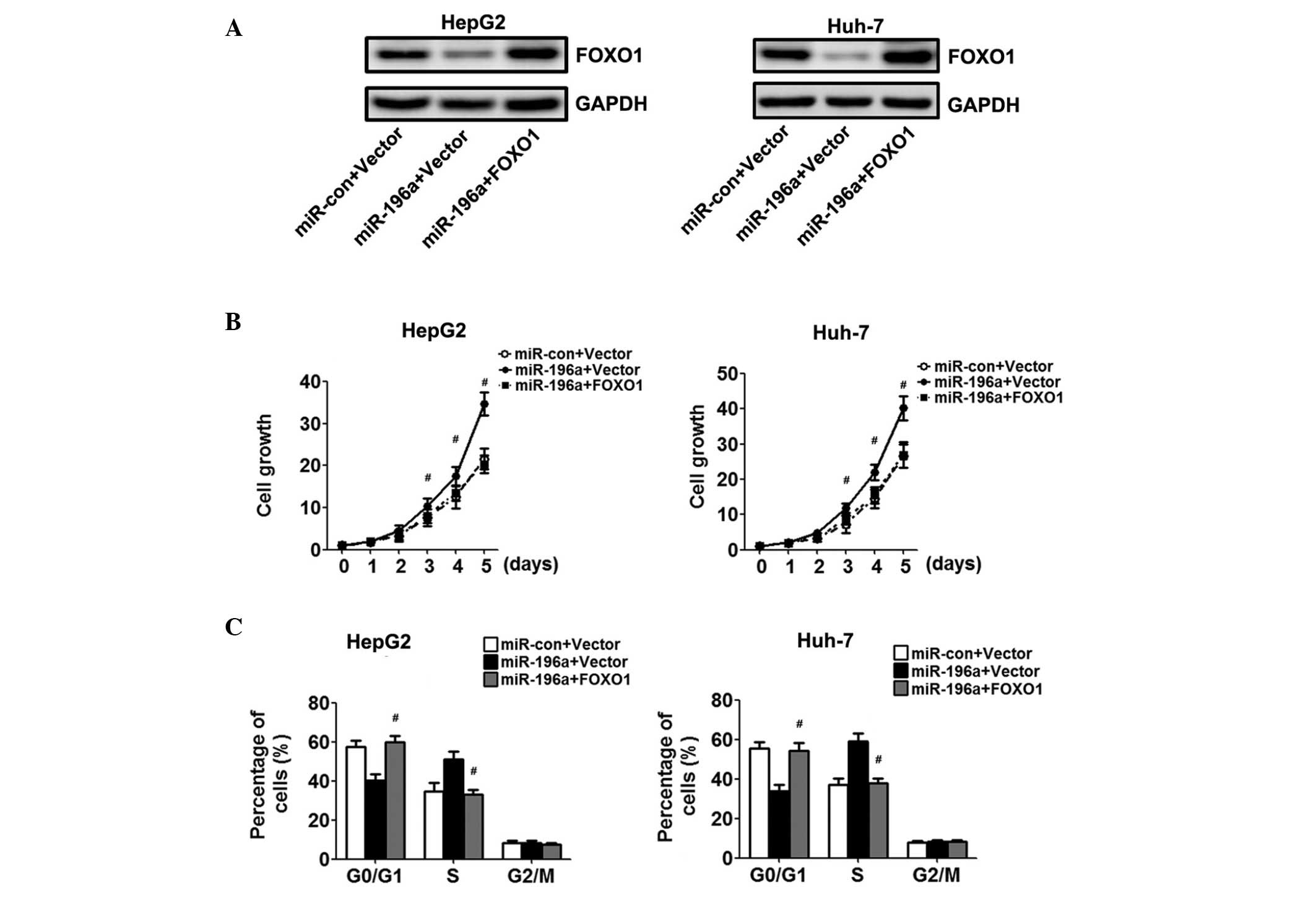HCV core protein-induced upregulation of microRNA-196a promotes aberrant proliferation in hepatocellular carcinoma by targeting FOXO1
- Authors:
- Published online on: April 22, 2016 https://doi.org/10.3892/mmr.2016.5159
- Pages: 5223-5229
Abstract
Introduction
Hepatocellular carcinoma (HCC) is the most common type of liver cancer and is the fifth most common type of cancer worldwide (1). The rate of HCC-associated mortality is >600,000 each year, and the 5-year survival rate is <9% (2,3). The majority of patients with HCC have chronic liver diseases, including chronic hepatitis infection (4,5). HCV infection has been the leading cause of chronic hepatitis, liver cirrhosis and HCC for decades (6). It is estimated that 200,000,000 individuals are chronically infected with HCV worldwide (7,8). Despite progress in understanding immunity against HCV infection and HCV pathogenesis, and progress in the development of effective direct-acting antivirals, no effective vaccine has been developed for HCV, and the current antiviral treatments have certain limitations.
HCV is a member of the Hepacivirus genus of the Flaviviridae family, and is represented by seven major genotypes. HCV contains a 9.6-kb positive strand RNA genome comprising a 5′-noncoding region (NCR), which includes an internal ribosome entry site, an open reading frame (ORF) that encodes structural and non-structural proteins, and a 3′ NCR. The structural proteins, which form the viral particle, include the core protein, and the envelope glycoproteins, E1 and E2 (9). Among the HCV viral proteins, the first structural protein encoded by the HCV ORF is the core protein, which forms the viral nucleocapsid. The HCV core protein is likely to be an important determinant in mediating the pathological effects of HCV through several multifunctional activities (10). Previous studies have indicated that the HCV core protein may be a potential oncoprotein in HCV-associated HCC, however, the HCV core regulatory mechanisms remain to be fully elucidated (11,12).
Previously, microRNAs, a class of genes transcribing small, highly conserved, 19–24-nucleotide noncoding RNAs, have emerged as potent regulators of gene expression by silencing messenger RNAs (mRNAs), which bind to the 3′-untranslated region (3′UTR) of target genes (13). MicroRNAs are critical in a number of normal biological processes, including the regulation of cellular differentiation, metabolism, proliferation, apoptosis and cancer (14). The aims of the present study were to investigate whether microRNAs are involved in HCV core protein-induced aberrant proliferation. The results may determine whether HCV core protein-induced upregulation of microRNA-196a is associated with HCC proliferation and the biological behavior of HCC, and may assist in elucidating the underlying mechanism.
Materials and methods
Cell culture and transfection
The human HepG2 and Huh-7 HCC cell lines were obtained from the American Type Culture Collection (Manassas, CA, USA) and grown in Dulbecco's modified Eagle's medium (DMEM; Invitrogen; Thermo Fisher Scientific, Inc., Waltham, MA, USA) supplemented with 10% foetal bovine serum (FBS) and 100 U/ml penicillin/streptomycin (both purchased from Invitrogen; Thermo Fisher Scientific, Inc.) at 37°C and 5% CO2 in a humidified chamber. miR-196a mimics and control miR mimics were purchased from Dharmacon (Austin, TX, USA). The cells were transfected with either the miR mimic (50 nM) or plasmid (200 ng) using HiPerFect transfection reagent (Qiagen, Valencia, CA, USA), according to the manufacturer's protocol. The cells were collected for analyses, which were performed 48 h following transfection.
Ad-HCV core adenovirus construction and infection
The Ad-HCV core adenovirus and the control Ad-enhanced green fluorescent protein (EGFP) adenovirus were constructed using the Ad-easy system (Invitrogen; Thermo Fisher Scientific, Inc.), as previously described (15). The HCC cells were seeded into a 6-well plate at a density of 3×105 cells per well and incubated at 37°C overnight until the cells were 50–70% confluent. The HCC cells were then infected with the Ad-MOCK, Ad-HCV core and control Ad-EGFP adenovirus, at a multiplicity of infection (MOI) of 50. After 48 h, the infection efficiency was evaluated by observing the expression of EGFP under a fluorescence microscope (Eclipse 90i; Nikon, Tokyo, Japan). The cells were collected for analyses, which were performed 48 h following infection.
RNA extraction and reverse transcription-quantitative polymerase chain reaction (RT-qPCR) analysis
The total RNA enriched with microRNAs was isolated from the HCC cells using a mirVana™ miRNA isolation kit (Applied Biosystems; Thermo Fisher Scientific, Inc.), according to the manufacturer's protocol. The expression of miR-196a was quantified using a Taqman MicroRNA assay (Applied Biosystems; Thermo Fisher Scientific, Inc.). Briefly, 10 ng of total RNA was used for reverse transcription to cDNA using specific stem-loop real-time primers (Shanghai Jade Lee Biotechnology Co., Ltd., Shanghai, China). The primer sequences were as follows: miR-196a forward, 5′-GTCGTATCCAGTGCAGGGTCCGAGGTA-3′ and reverse, 5′-TTCGCACTGGATACGACAGCAAAAATGTG-3′; U6 forward, 5′-GTCGTATCCAGTGCAGGGTCCGAGGT-3′ and reverse, 5′-ATTCGCACTGGATACGACAAAAATATGG-3′. The reverse transcription primers for the specific microRNAs were used to amplify the cDNA from the microRNA. The PCR reaction mixture was composed of 1 μl cDNA, 0.5 μl primer and 5 μl SYBR Green PCR master mix buffer (total volume, 10 μl). qPCR was performed with 30 cycles of the following: 30 Sec at 98°C, 90 sec at 58°C and 20 sec at 72°C; with a final extension at 72°C for 5 min using ABI Prizm 7500 PCR machine and TaqMan Universal PCR Master mix (Applied Biosystems; Thermo Fisher Scientific, Inc.). All primers were obtained from the TaqMan miRNA assays (Applied Biosystems; Thermo Fisher Scientific, Inc.). The relative quantification of miR-196a was calculated using the 2−ΔΔCq method (16). The data were normalised using U6 as an internal control, and the data were measured relative to a calibrator sample as the external control.
Cell proliferation assay
To determine the cell proliferation capacity, the HCC cells were monitored using cell growth curves. The cells were plated into 96-well plates (4×103 cells/well), and the cell viability was documented every day for 5 days using a Cell Counting Kit-8 (CCK-8; Dojindo Laboratories, Kumamoto, Japan). The absorbance values in each well at 450 and 510 nm were measured using a Benchmark Microplate Reader (Bio-Rad Laboratories, Inc., Hercules, CA, USA).
Cell cycle assay
For cell cycle analysis, the cells were collected by centrifugation (12,000 × g at 4°C for 5 min) 48 h following infection or transfection, washed with cold phosphate-buffered saline (PBS), fixed with 70% cold ethanol, and incubated at −20°C overnight. The fixed cells were then collected, washed with PBS, resuspended in Tris-HCl buffer (pH 7.4) supplemented with 100 μg/ml RNase A (Sigma-Aldrich, St. Louis, MO, USA) and labelled for 30 min with 50 μg/ml propidium iodide (Sigma-Aldrich). Cell cycle analysis was performed on a flow cytometer (FACSCanto; BD Biosciences, Franklin Lakes, NJ, USA) using ModFit LT software version 3.2 (Verity Software House, Inc., Topsham, ME, USA).
Western blot analysis
The cells were lysed on ice using M-PER mammalian protein extraction reagent (Cell Signaling Technology, Inc., Boston, USA). Protein concentration was quantified using a Bradford assay (Bio-Rad Laboratories, Inc.) The protein (30 mg) was separated by 10% SDS-PAGE and transferred onto a polyvinylidene fluoride membrane (Amersham Biosciences, Buckinghamshire, UK). Then, the membranes were blocked with 5% skim milk at room temperature for 1 h, and washed in 0.05% Tris-buffered saline (Sigma-Aldrich) with Tween 20 for 5 min three times. The membranes were probed with primary antibodies against FOXO1 (cat. no. 2880) and GAPDH (cat. no. 5174) (both dilution, 1:1,000; both rabbit monoclonal; both purchased from Cell Signaling Technology, Inc.) overnight at 4°C, followed by incubation with secondary antibodies at 37°C for 1 h. The bands were detected using enhanced chemiluminescence (Pierce Biotechnology, Inc., Rockford, IL, USA) and visualised using the ChemiDoc XRS system (Bio-Rad Laboratories, Inc.).
Plasmid construction
To construct the luciferase reporter vector, the full-length 3′UTR of FOXO1, as well as a mutant sequence of FOXO1, were synthesised using PCR. PCR was performed under the follow thermal cycling conditions for 30 cycles: 30 Sec at 95°C, 90 sec at 60°C and 30 sec at 72°C; with a final extension at 72°C for 5 min using a ABI Prizm 7500 PCR machine (Applied Biosystems; Thermo Fisher Scientific, Inc.) The primers used contained the following restriction sites: FOXO1 3′UTR, forward 5′-ACTAGTGAAGTGCCAAACTCACTACA-3′ and reverse 5′-AAGCTTTACAAAGCTGGCATTTAATC-3′; and Mut FOXO1 3′UTR, forward 5′-CTTTTGTTTGTAAGAACTGTTTTCTGCGGA-3′ and reverse 5′-TCCGCAGAAAACAGTTCTTACAAACAAAAG-3′. The PCR product from the FOXO1 3′UTR was cloned into the SpeI and HindIII restriction sites downstream of the luciferase ORF in the pMIR-report vector (Ambion, Carlsbad, CA, USA).
For re-expression, FOXO1 without the 3′UTR was amplified using PCR with the following primers: Forward 5′-ATGGCCGAGGCGCCTCAGGTG-3′ and reverse 5′-TCAGCCTGACACCCAGCTATGT-3′. The resulting PCR amplicons of FOXO1 were cloned into the T vector (Promega Corp., Madison, WI, USA). The correct clones were confirmed by sequencing.
Luciferase reporter assays
For the luciferase assay, the HCC cells were grown to 70–80% confluence in 24-well plates and co-transfected with the firefly luciferase reporter vector containing the FOXO1 3′UTR or its mutant 3′UTR, and miRNA mimics (50 nM) using Lipofectamine™ 2000 reagent (Invitrogen; Thermo Fisher Scientific, Inc.), according to the manufacturer's protocol. A luciferase activity assay was performed 48 h following co-transfection using a Dual-Luciferase Reporter Assay System (cat. no. E1980; Promega Corp.), and the values were normalised with Renilla luciferase activity.
Statistical analysis
All data were analyzed using SPSS version 17.0 (SPSS Inc., Chicago, IL, USA). All data are shown as the mean ± standard deviation. Significant differences were analysed using Student's t-test for comparisons between two groups, and one-way analysis of variance or the non-parametric Kruskal-Wallis H test were used for multiple comparisons. P<0.05 was considered to indicate a statistically significant difference.
Results
Ad-HCV core infection upregulates the expression of miR-196a in HCC cells
The HepG2 and Huh-7 cells were infected with Ad-HCV core or Ad-GFP at an MOI of 50, and the infection efficiency was evaluated by observing the expression of EGFP under a fluorescence microscope (Fig. 1A). Western blot analysis confirmed the efficient transient expression of the HCV core protein at 48 h-post Ad-HCV core infection (Fig. 1B and C). The present study subsequently examined whether the level of miR-196a is affected by HCV core overexpression. As shown in Fig. 1D, the level of miR-196a was significantly higher in the Ad-HCV core-infected cells, compared with the expression level in the Ad-MOCK control group.
Overexpression of miR-196a promotes cell growth and the G1-S transition
A previous study demonstrated that Ad-HCV core infection promotes cell growth and the G1-S transition (15). To confirm the hypothesis that the HCV core protein affects the proliferation of HCC cells via the upregulation of miR-196a, miR-196a was overexpressed in the HepG2 and Huh-7 cells by transfection with miR-196a mimics. Increased expression of miR-196a was confirmed using RT-qPCR (Fig. 2A). Using cell growth curves, it was found that the miR-196a mimic promoted the growth of the HCC cells, compared with the control cells (Fig. 2B). In addition, marked promotion of the G1/S transition was observed by the miR-196a mimics (Fig. 2C). Overall, these data suggested that miR-196a promoted HCC cell proliferation by inducing the G1-S transition.
FOXO1 is a direct target of miR-196a
As microRNAs regulate the expression of mRNAs by targeting the 3′UTR of relative mRNAs, the present study detected the target of miR-196a in HCC cells. A previous study reported that FOXO1 serves as a target of miR-196a post-transcriptional repression in cervical cancer (17). To identify whether FOXO1 is regulated by miR-196a in HCC, HepG2 and Huh-7 cells were transfected with miR-196a mimics. Western blot analysis showed that the miR-196a mimics markedly inhibited the protein expression of FOXO1 in HCC cells (Fig. 3A). To verify whether FOXO1 is a direct target of miR-196a in HCC cells, the potential seed sequence for miR-196a in the 3′UTR of FOXO1 was analysed, and the wild-type and mutant FOXO1 3′UTR fragments were cloned into a luciferase reporter gene system (Fig. 3B). The wild-type or mutant FOXO1 3′UTR constructs were co-transfected with the miR-196a or control mimics into the HepG2 and Huh-7 cells, and luciferase activity was measured. The luciferase reporter assay indicated that transfection with miR-196a led to inhibition of the wild-type 3′UTR, however, miR-196a had no effect on the luciferase intensity controlled by the mutant 3′UTR (Fig. 3C).
Overexpression of FOXO1 reverses miR-196a-mediated proliferation
To confirm the hypothesis that miR-196a affects the proliferation of HCC cells via the downregulation of FOXO1, the HepG2 and Huh-7 cells overexpressing miR-196a were transfected with a FOXO1 construct lacking the respective 3′UTR, or an empty vector. Western blot analysis demonstrated increased protein expression levels of FOXO1 in the cells co-transfected with the FOXO1 recombinant plasmid, compared with the cells transfected with the empty vector (Fig. 4A). Overexpression of FOXO1 resulted in growth inhibition of the HCC cells, as assessed using the CCK-8 assay (Fig. 4B). Cell cycle assays showed that the overexpression of FOXO1 restored the percentage of cells in the G0/G1 phase and reversed the enhanced proliferation effect of miR-196a (Fig. 4C).
Discussion
HCV-associated infection, which is present worldwide, increasingly contributes to health care expenditures, morbidity rates and mortality rates (18). Although substantial progress has been made in previous years in determining the structure and function of HCV proteins, the HCV viral load does not necessarily correlate with the severity and progression of the disease. Therefore, the investigation of a novel regulatory mechanism for the diagnosis and treatment of HCV-associated infections is required. The HCV core protein is likely to be an important determinant in mediating the pathological effects of HCV (11,12). There is accumulating evidence that the HCV core protein can exert a regulatory function through the expression of microNAs (19).
miR-196a has been shown to be crucial in normal cell differentiation and proliferation, and in the tumorigenesis of various types of cancer (20–23). The upregulation of miR-196a correlates with aggressive progression and unfavourable prognoses in colorectal cancer, gastric cancer, non-small cell lung cancer, osteosarcoma and other types of cancer (24–27). A previous report suggested that circulating miR-196a is a specific and non-invasive candidate biomarker for the diagnosis of chronic HCV infection (28). A subsequent study demonstrated that HCV infection markedly enhances the expression of miR-196a in hepatocytes, and that HCV replication is required for the upregulation of miR-196a, which suggests that miR-196a is critical in HCV-associated infection (29). The data obtained in the present study indicated that ectopic expression of the HCV core protein enhanced the expression of miR-196a. The overexpression of miR-196a significantly inhibited HCC cell growth due to S phase accumulation. These results were consistent with previous studies demonstrating that miR-196a may have oncogenic role in tumourigenesis and tumour progression.
As for the mechanism of miRNA regulation in cancer, it is crucial to validate target genes. FOXO1 has been identified as one of the high-scoring candidate genes for miR-196a targets by several in silico methods for target gene prediction, including PicTar, TargetScan and microRNA databases (30). A previous study provided direct evidence that FOXO1 is a direct target of miR-196a in cervical cancer cells (16). FOXO1 belongs to the FOXO subfamily of forkhead transcription factors, which contain evolutionarily conserved transcriptional activators that are characterised by a highly conserved forkhead domain with a DNA-binding motif (31). A previous study provided direct evidence that FOXO1 is a potent transcriptional activator, which triggers the expression of a program of genes involved in cell cycle arrest, apoptosis, DNA repair and hypoxia responsiveness (32–34). FOXO1 is also known to be a tumour suppressor, and the upregulation of FOXO1 induces cell cycle arrest in HCC (35,36). In the present study, through the prediction of molecular information, FOXO1 was confirmed as a direct target gene for miR-196a, and it was shown that miR-196a negatively regulated the expression of FOXO1 expression by directly targeting the 3′UTR of FOXO1 mRNA in the cells. Additionally, the present study demonstrated that the inhibitory effect of miR-196a on cell growth was reversed by overexpressing FOXO1, which suggested that miR-196a promoted cell growth by suppressing the expression of FOXO1.
In conclusion, the present study was the first, to the best of our knowledge, to identify the potential role of miR-196a in HCV core-mediated HCC proliferation and its underlying mechanisms. The findings of the present study revealed that the HCV core promoted the upregulation of miR-196a, and was crucial in HCC cell proliferation, possibly through the indirect targeting of FOXO1 by miR-196a. Understanding the precise role of miR-196a in the induction of tumour cell proliferation is likely to increase our understanding of the biology of HCV-associated HCC, and the inhibition of miR-196a may represent a novel therapeutic strategy for the treatment of HCV-associated HCC.
References
|
Berasain C, Perugorria MJ, Latasa MU, Castillo J, Goñi S, Santamaría M, Prieto J and Avila MA: The epidermal growth factor receptor: A link between inflammation and liver cancer. Exp Biol Med (Maywood). 234:713–725. 2009. View Article : Google Scholar | |
|
Sherman M: Hepatocellular carcinoma: Epidemiology, risk factors and screening. Semin Liver Dis. 25:143–154. 2005. View Article : Google Scholar | |
|
El-Serag HB and Rudolph KL: Hepatocellular carcinoma: Epidemiology and molecular carcinogenesis. Gastroenterology. 132:2557–2576. 2007. View Article : Google Scholar : PubMed/NCBI | |
|
Kremsdorf D, Soussan P, Paterlini-Brechot P and Brechot C: Hepatitis B virus-related hepatocellular carcinoma: Paradigms for viral-related human carcinogenesis. Oncogene. 25:3823–3833. 2006. View Article : Google Scholar : PubMed/NCBI | |
|
Lupberger J and Hildt E: Hepatitis B virus-induced oncogenesis. World J Gastroenterol. 13:74–81. 2007. View Article : Google Scholar : PubMed/NCBI | |
|
Brody H: Hepatitis C. Nature. 474:S12011. View Article : Google Scholar : PubMed/NCBI | |
|
Gravitz L: Introduction: A smouldering public-health crisis. Nature. 474:S2–S4. 2011. View Article : Google Scholar : PubMed/NCBI | |
|
Thomas DL: Global control of hepatitis C: Where challenge meets opportunity. Nat Med. 19:850–858. 2013. View Article : Google Scholar : PubMed/NCBI | |
|
Moradpour D and Penin F: Hepatitis C virus proteins: from structure to function. Curr Top Microbiol Immunol. 369:113–142. 2013.PubMed/NCBI | |
|
Zhang Y, Li RQ, Feng XD, Zhang YH and Wang L: Down-regulation of PTEN by HCV core protein through activating nuclear factor-κB. Int J Clin Exp Pathol. 7:7351–7359. 2014. | |
|
Watashi K and Shimotohno K: The roles of hepatitis C virus proteins in modulation of cellular functions: A novel action mechanism of the HCV core protein on gene regulation by nuclear hormone receptors. Cancer Sci. 94:937–943. 2003. View Article : Google Scholar : PubMed/NCBI | |
|
Siavoshian S, Abraham JD, Kieny MP and Schuster C: HCV core, NS3, NS5A and NS5B proteins modulate cell proliferation independently from p53 expression in hepatocarcinoma cell lines. Arch Virol. 149:323–336. 2004. View Article : Google Scholar : PubMed/NCBI | |
|
Farh KK, Grimson A, Jan C, Lewis BP, Johnston WK, Lim LP, Burge CB and Bartel DP: The widespread impact of mammalian MicroRNAs on mRNA repression and evolution. Science. 310:1817–1821. 2005. View Article : Google Scholar : PubMed/NCBI | |
|
Ell B and Kang Y: MicroRNAs as regulators of bone homeostasis and bone metastasis. Bonekey Rep. 3:5492014. View Article : Google Scholar : PubMed/NCBI | |
|
Huang S, Xie Y, Yang P, Chen P and Zhang L: HCV core protein-induced down-regulation of microRNA-152 promoted aberrant proliferation by regulating Wnt1 in HepG2 cells. PLoS One. 9:e817302014. View Article : Google Scholar : PubMed/NCBI | |
|
Livak KJ and Schmittgen TD: Analysis of relative gene expression data using real-time quantitative PCR and the 2−ΔΔCt method. Methods. 25:402–408. 2001. View Article : Google Scholar | |
|
Hou T, Ou J, Zhao X, Huang X, Huang Y and Zhang Y: MicroRNA-196a promotes cervical cancer proliferation through the regulation of FOXO1 and p27Kip1. Br J Cancer. 110:1260–1268. 2014. View Article : Google Scholar : PubMed/NCBI | |
|
Eckman MH, Talal AH, Gordon SC, Schiff E and Sherman KE: Cost-effectiveness of screening for chronic hepatitis C infection in the United States. Clin Infect Dis. 56:1382–1393. 2013. View Article : Google Scholar : PubMed/NCBI | |
|
Akamatsu S, Hayes CN, Tsuge M, Miki D, Akiyama R, Abe H, Ochi H, Hiraga N, Imamura M, Takahashi S, et al: Differences in serum microRNA profiles in hepatitis B and C virus infection. J Infect. 70:273–287. 2015. View Article : Google Scholar | |
|
Liu CJ, Tsai MM, Tu HF, Lui MT, Cheng HW and Lin SC: miR-196a overexpression and miR-196a2 gene polymorphism are prognostic predictors of oral carcinomas. Ann Surg Oncol. 20(Suppl 3): S406–S414. 2013. View Article : Google Scholar | |
|
Liu P, Xin F and Ma CF: Clinical significance of serum miR-196a in cervical intraepithelial neoplasia and cervical cancer. Genetics and molecular research: GMR. 14:17995–18002. 2015. View Article : Google Scholar | |
|
Li JH, Luo N, Zhong MZ, Xiao ZQ, Wang JX, Yao XY, Peng Y and Cao J: Inhibition of microRNA-196a might reverse cisplatin resistance of A549/DDP non-small-cell lung cancer cell line. Tumour Biol. Sept 16–2015.Epub ahead of print. | |
|
Li SC, Shi H, Khan M, Caplin M, Meyer T, Öberg K and Giandomenico V: Roles of miR-196a on gene regulation of neuroendocrine tumor cells. Mol Cell Endocrinol. 412:131–139. 2015. View Article : Google Scholar : PubMed/NCBI | |
|
Ge J, Chen Z, Li R, Lu T and Xiao G: Upregulation of microRNA-196a and microRNA-196b cooperatively correlate with aggressive progression and unfavorable prognosis in patients with colorectal cancer. Cancer Cell Int. 14:1282014. View Article : Google Scholar : PubMed/NCBI | |
|
Liu XH, Lu KH, Wang KM, Sun M, Zhang EB, Yang JS, Yin DD, Liu ZL, Zhou J, Liu ZJ, et al: MicroRNA-196a promotes non-small cell lung cancer cell proliferation and invasion through targeting HOXA5. BMC Cancer. 12:3482012. View Article : Google Scholar : PubMed/NCBI | |
|
Tsai MM, Wang CS, Tsai CY, Chen CY, Chi HC, Tseng YH, Chung PJ, Lin YH, Chung IH, Chen CY and Lin KH: MicroRNA-196a/-196b promote cell metastasis via negative regulation of radixin in human gastric cancer. Cancer Lett. 351:222–231. 2014. View Article : Google Scholar : PubMed/NCBI | |
|
Zhang C, Yao C, Li H, Wang G and He X: Combined elevation of microRNA-196a and microRNA-196b in sera predicts unfavorable prognosis in patients with osteosarcomas. Int J Mol Sci. 15:6544–6555. 2014. View Article : Google Scholar : PubMed/NCBI | |
|
Liu B, Xiang Y and Zhang HS: Circulating microRNA-196a as a candidate diagnostic biomarker for chronic hepatitis C. Mol Med Rep. 12:105–110. 2015.PubMed/NCBI | |
|
Mukherjee A, Di Bisceglie AM and Ray RB: Hepatitis C virus-mediated enhancement of microRNA miR-373 impairs the JAK/STAT signaling pathway. J Virol. 89:3356–3365. 2015. View Article : Google Scholar : PubMed/NCBI | |
|
Shang Y, Wang LQ, Guo QY and Shi TL: MicroRNA-196a overexpression promotes cell proliferation and inhibits cell apoptosis through PTEN/Akt/FOXO1 pathway. Int J Clin Exp Pathol. 8:2461–2472. 2015.PubMed/NCBI | |
|
Greer EL and Brunet A: FOXO transcription factors at the interface between longevity and tumor suppression. Oncogene. 24:7410–7425. 2005. View Article : Google Scholar : PubMed/NCBI | |
|
Calnan DR and Brunet A: The FoxO code. Oncogene. 27:2276–2288. 2008. View Article : Google Scholar : PubMed/NCBI | |
|
Myatt SS and Lam EW: The emerging roles of forkhead box (Fox) proteins in cancer. Nat Rev Cancer. 7:847–859. 2007. View Article : Google Scholar : PubMed/NCBI | |
|
Paik JH, Kollipara R, Chu G, Ji H, Xiao Y, Ding Z, Miao L, Tothova Z, Horner JW, Carrasco DR, et al: FoxOs are lineage-restricted redundant tumor suppressors and regulate endothelial cell homeostasis. Cell. 128:309–323. 2007. View Article : Google Scholar : PubMed/NCBI | |
|
Yang XW, Shen GZ, Cao LQ, Jiang XF, Peng HP, Shen G, Chen D and Xue P: MicroRNA-1269 promotes proliferation in human hepatocellular carcinoma via downregulation of FOXO1. BMC Cancer. 14:9092014. View Article : Google Scholar : PubMed/NCBI | |
|
Lee SY, Lee GR, Woo DH, Park NH, Cha HJ, Moon YH and Han IS: Depletion of Aurora A leads to upregulation of FoxO1 to induce cell cycle arrest in hepatocellular carcinoma cells. Cell Cycle. 12:67–75. 2013. View Article : Google Scholar : |













